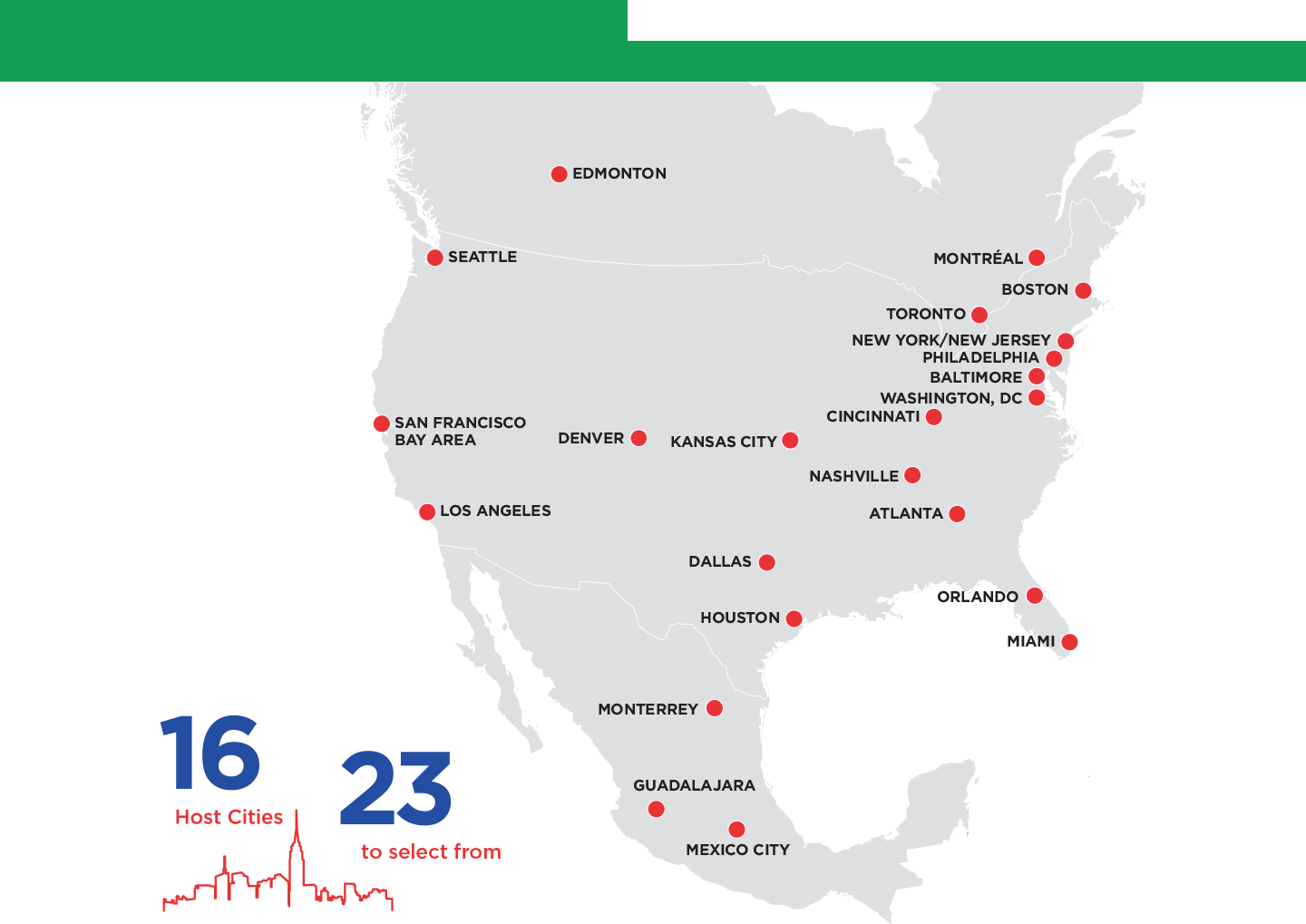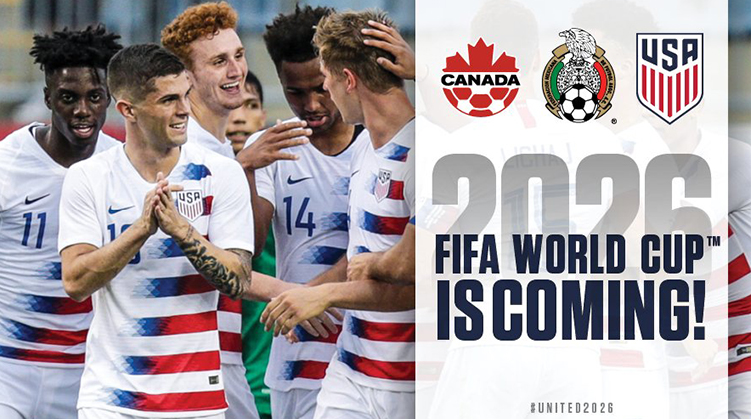BREAKING NEWS: The 2026 FIFA World Cup is coming to the USA
Soccer marketing news doesn’t get any bigger. The FIFA Congress has awarded the right to host the 2026 FIFA World Cup to the United Bid of Canada, Mexico, and the United States.
Wait, the World Cup is going to be hosted by three countries?
Yes, for the first time ever three nations; Canada, Mexico, and the United States, will co-host a FIFA World Cup. For Canada, it’s a first-time opportunity to stage soccer’s crown jewel event. For the U.S. it will be a 32-year gap since the transformative World Cup 1994, and for Mexico 40 years since the 1986 games.
It will also be the largest World Cup ever with 48 participating countries, up from the current 32. That’s 80 matches [as opposed to the current 64] with 60 taking place in the U.S. and 10 each in Canada and Mexico.
Where will the matches be played?
The United bid identifies 23 potential host cities from which 16 will be selected: 10 in the U.S. and 3 each from Canada and Mexico.
The Final will be played at MetLife Stadium in New Jersey, with the semis in Atlanta and Dallas.

While the host cities will receive tremendous attention, the 2026 World Cup experience will be one for all of America. Expect to see hundreds of public viewing events in communities all across the country: a phenomenon that came to the forefront during World Cup 2010 and 2014 and demonstrated the unique power of soccer to bring people together. Expect also to see technology enabled pop up experiences providing fans a taste of the action and an opportunity to engage with the tournament wherever they may be. World Cup inspired programs will be integrated into schools and part of community initiatives. This will truly be a World Cup that engages all of North America.
That’s a big event – what are the projected financials?
The United 2026 bid projects revenues in excess of $14B with profits of $11B. These are staggering figures particularly when you consider that FIFA’s projection for the upcoming four-year term through World Cup 2022 in Qatar is $6.56B. While some industry leaders have questioned the validity of these projections, there is absolutely no doubt that the event will be profitable on the level never previously seen. This is a key fact when considering the potential impact of the event globally as well of course in the host nations.
What does this really mean for soccer in America?
This is a huge opportunity for the sport of soccer in each of the three hosting nations but thinking specifically about the U.S. for a moment it’s a potential game changer. Here’s why.
World Cup 2026 is not merely a high-profile month-long event, it’s a symbolic North Star happening that can galvanize, showcase and influence the sport of soccer for the next decade and well beyond.
Rarely is there an opportunity for all of soccer’s contributing sectors and organizations to align behind a unified effort to advance the sport of soccer holistically. World Cup 2026 does exactly this. It provides every soccer constituent with the chance to be part of the action, to make a contribution, to support one goal, and also directly benefit from the impact and legacy of the movement.
The U.S. doesn’t need to build stadiums, hotels, and other basic infrastructure to host the event. With these things in place and total confidence in logistics and management expertise, soccer leaders can shift their focus squarely onto developing impact programs. Programs that will truly make a contribution to the growth of the sport, fuel fan interest, and positively impact the lives of individuals and society in general. Stimulating increased soccer participation in underserved communities is a key initiative for many. So is advancing gender equality. There are many needs to be served, but with an eight-year runway and the financial expectations at play, World Cup 2026 delivers the perfect backdrop and foundation for truly meaningful developments to occur.
What’s the impact of this on the presence of international soccer clubs in the U.S.?
Soccer, of course, is the global sport and the U.S. has been at the forefront of thinking for the international football industry for a few years now. Today’s announcement will effectively reinforce the perspective that “the U.S. is the place be.” Expect many of the leading global soccer brands (leagues and teams) to double down on their presence in the U.S. Some will invest and contribute to the growth of the game, others, however, will merely look to ride the wave and extract dollars from the market.
What does this mean for FIFA and its corporate partners?
World Cup 2026 presents a watershed moment for FIFA. The corruption scandal of 2015 hit the organization and its brand image hard and several partners (Johnson & Johnson, Continental, Castrol) withdrew their support. According to reports, World Cup sponsorship revenue for Russia is down US$179M
North America, however, is the largest sports sponsorship market in the world. Such is the enormity of the opportunity it’s quite likely several major brands will show interest in either regional or global opportunities with FIFA. United 2026 bid documents project a total of $3.6B in sponsorship revenue.
This may well be FIFA’s best opportunity to re-establish itself (on some level) as a marque trusted sports sponsorship platform. Creative, impactful and transparent commitments by FIFA to utilize the projected funds from the event could go a long way to helping improve the organization’s image, particularly with western companies. Longtime FIFA global brand partners (adidas, Coke, Budweiser, McDonald’s, Visa) will surely be expecting positive actions on this front.
For these same companies, of course, World Cup 2026 signifies the biggest market opportunity in recent memory. The GDP of the 2026 host nations is almost three times that of the host nations for the four previous World Cups combined.

What about US Soccer sponsors and those partnered with Mexico and Canada?
This is arguably where the biggest 2026 World Cup-related brand opportunities lie. Partners of the respective Federations can leverage (within FIFA guidelines) their official associations during the event. Additionally, though, they have the ability to go well beyond the event window and build activations during the months/years leading into the event, as well as after the event.
With the benefit of a long lead time, smart marketers will be thinking about how they can partner with a Federation to develop authentic and meaningful community and fan engagement platforms that have more than a fleeting value to the sport and their brand.
The countdown to World Cup 2026 begins. ~2,921 days to go!
Categories: Broadcast, Commercial, Featured, FIFA, Sponsorship, U.S. Soccer, World Cup
